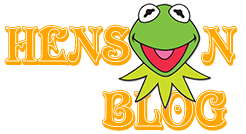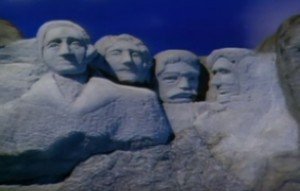The Muppet Show: Sex and Violence
And Pigs in Space and the Swedish Chef’s show aren’t the only Muppet Show recurring sketches foreshadowed in Sex and Violence. Its running gag showing the 4 president heads at Mt. Rushmore cracking puns with each other is extremely reminiscent of mini-sketches such as The Muppet Show‘s talking houses, with a similar get-in tell-a-pun get-out-quick set-up, making them basically old-fashioned newspaper comic strips brought to life.
Other scenes, such as one in which a variety of birds act out courtship rituals by each communicating with one another with a single repeated phrase, and the one in which two monsters made of fabric attack two snooty, female-coded abstract characters, all communicating only through strange sounds, is reminiscent both of some of the Muppets’ variety show sketches, such as “Business Business” and other similarly arty/strange sketches to come on The Muppet Show. The “Theatre of Things,” in which all the puppets are simple office supplies also foreshadows similar bits on The Muppet Show. In this sketch, a kingdom of pencils is taken over by a new ruler (the ruler is a ruler, get it?), his speech sprinkled with puns such as “The last ruler was crooked…He couldn’t measure up…I’ll tell you where to draw the line!”
Sex and Violence also brings us our very first edition of “At the Dance,” a sketch that was in practically every first season episode of The Muppet Show and continued to appear sporadically throughout most of the run. The basic idea was there would be a ballroom of Muppets dancing in couples, and over the course of each edition, various couples would come to the forefront, tell a usually very groanworthy joke, and then recede as another couple came to the forefront. This first version of the concept relies less on puns (though it has a few) and more on meta references to the framework of the show itself and/or peoples’ knowledge of the Muppets. For example, Nigel tells his dance partner, “Well, y’see, this show jumps from place to place. You’ll get used to it.” Later on, in his sole line, Kermit tells the girl he’s dancing with, “I might be able to get you a job on an educational show for kids,” which reminds me a bit of Big Bird’s classic cameo in The Muppet Movie, where he tells Kermit and Fozzie of his plans to break into public television.
And speaking of Sesame Street, as in Valentine, Bert and Ernie make a cameo here, as well. Bert is dancing with a girl who we, at first, only see from behind. He tells her, “You look really familiar”. Then, as they spin, we see “her” face and discover that it’s either Ernie in drag or a girl who looks shockingly similar to him! Funnily enough, given these are Sesame Street characters, this is one of Sex and Violence‘s few truly subversive jokes, hinting at Bert and Ernie’s gay subtext. And a little later, they even manage to sneak in a hilariously grotesque one, when the evil Dr. Nauga brandishes a knife at a dancing couple and asks the man, regarding the woman, “Mind if I cut in?” Dark.
And then we have a final meta gag with Rowlf dancing with a partner and telling her, “I was with Jimmy Dean but no one remembers me anymore,” which, in retrospect is sad, happy, and then comes around to sad again, given that, although he doesn’t know it, he has some of his best, most classic days still ahead of him in The Muppet Show and The Muppet Movie, yet he’ll also practically languish away in obscurity for many years after Jim died. For a long time, they couldn’t find a performer who they felt could embody him and although Bill Barretta eventually took over, he has never been as prominent up to this point.
The special also has a number of Muppety sight gags, such as a framed celebrity photo–hanging in the background of the control room–which changes in each scene, starting with Julie Andrews (as an acknowledgment of their work together), and eventually getting more surreal. One time it’s Mona Lisa, another Little Orphan Annie, and finally, Big Bird. In another cute moment, we see a Muppet goldfish swimming in the water fountain, and then Animal locked up in a dungeon with bars built into the studio wall. And as in other Muppet productions, we often see other Muppets cameoing in the background of scenes. For example, the frogs from The Frog Prince and Miss Mousey show up in “At the Dance,” and we see Catgut from The Muppet Musicians of Bremen in the audience of the wrestling match.
And, as previously mentioned, there is a rudimentary plot–albeit primitive compared to the more developed Muppet Show plots–involving a Seven Deadly Sins pageant. This conceit is pretty clever and leads to some imaginative puppet designs such as Avarice, who has dollar signs for eyes, gold teeth, and a pimp hat, and the green, spiky, virus-looking Envy, along with some typically Muppety mix-ups when a leafy green vegetable mistakenly shows up, as her agent thought it was a “4 basic food groups” pageant. However, it’s really more of a running joke than a true story and in the end, it proves to be entirely anticlimactic. Before the final commercial break, the announcer tells us to come back for the results of who won the pageant, and then when we return, he tells us that we’ll have to find out next week, as the show has accidentally run out of time.
Now, on the one hand, it’s a nice and subversive little twist to have us waiting on an answer that never comes, mocking television conceits as Jim always loved to do since the beginning of his career (in some ways, it’s a much lighter spin on the grim Waiting-for-Godot-ness of The Cube), but on the other, it really does seem to let the air out of the tires. Sure, the idea is that this pageant-that-never-materialized was never really the point, after all, but given it was the only real plot thread to follow, it makes the whole thing feel incomplete and pointless, especially with no human guest star or strong theme holding it together (even a fun little tag, in which Sloth finally appears, sleepily asking if he’s late, does little to help this sense of unfulfillment). If this ending could trick me into even momentarily disregarding all of the genuinely excellent Muppet stuff that this pilot did provide, I could definitely see that going fourfold for ABC network execs.
And so, in the end, another fascinating curiosity for today’s Muppet fan, one which introduces a lot of characters and elements that would eventually prove to be crucial to The Muppet Show‘s success but also loses some of the more biting humor and heart, along with the presence of a human guest star, that made The Muppet Show, The Muppet Show. Next time: an interview that Jim Henson and Kermit gave Johnny Carson about this very special, along with another Sesame Street appearance on The Electric Company!



